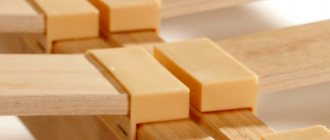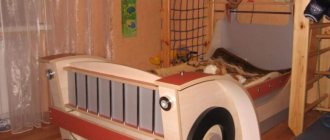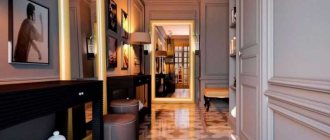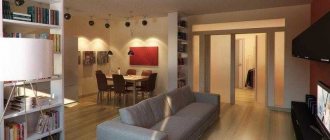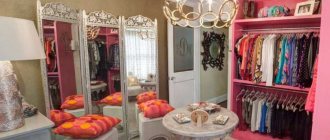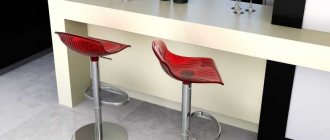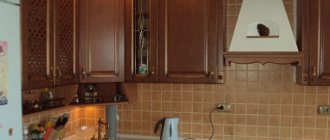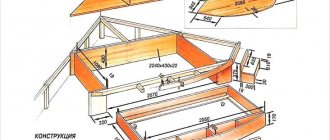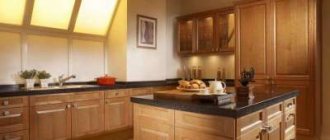Kitchen lighting under cabinets — desirable elements of the lighting system. Ceiling light sources are not enough. After all, during work a shadow is formed from the human body, and this can lead to injuries. Additional lighting installed under cabinets not only increases safety and creates more comfortable conditions for working with cutting objects. With proper planning, the design of the room itself is emphasized.
Lighting can make interior design more sophisticated
Backlight planning
Before buying any lighting fixture, determine its location and layout. There are several ways to place lamps: near the wall, closer to the doors, in the middle. It is best, according to designers, to install lamps as indicated in the last two options . Then fewer shadows are formed, which increases the safety of working with cutting and stabbing tools.
Ways to illuminate the work area in the kitchen
However, the last two options have disadvantages: often such placement is not very aesthetically pleasing. In addition, if there is a dining table or sofa opposite, the light disturbs the people there. In this case there is also a solution. A decorative strip is placed on the edge of the wall cabinet so that it covers the lighting fixture. The additional element also softens the light. The height of the bar is determined depending on the type of lamp used and its location.
Useful idea. If you don’t like the idea of a protective screen board, but there is no other choice, then you can use this element to your advantage. For example, turn it into a shelf for various small things.
In order for the backlight to cope with the tasks assigned to it, it is necessary to follow the rules for its installation.
It is recommended to install spotlights at a distance of about 40 cm, from the wall - 20 cm . One device is enough to illuminate 1.5 square meters. m.
Leave a distance of 30–40 cm between lamps
Important! If you place point light sources at too great a distance, a contrasting light “zebra” will form. To eliminate this, install additional lamps.
Profile installation
Installation of profiles is carried out using a drill and screws with countersunk heads. When you work on LED strips, this will make installation easier. The size of the consumable is determined based on what the profile is made of.
Use an electronic tape measure to correctly determine the length of your kitchen set
After the fastening is completed, the surface must be cleaned and degreased. This procedure will help ensure a secure installation. The same steps are performed if the lighting in the kitchen is mounted using an overhead or corner profile. Use a mortise profile that does not require fastening. But this installation is not suitable for all cabinets.
Profile fastening
Do-it-yourself installation of an aluminum profile should be done very carefully. The appearance in your kitchen lighting should not cause discomfort and provide access to the strips so as not to dismantle the cabinet.
We proceed to installation of the selected tape. Do-it-yourself installation of LED strips is carried out after placing the profile.
The tape is cut to the required length using special marks
Installation is carried out in the following steps
- Make a cut from the skein with the desired length. Remove silicone from the backlight contacts;
- Now you need to do soldering to the contacts. The LED strips have an adhesive layer at the bottom, remove the protective film. Attach the backlit tape to the profile;
- Next, attach a screen that diffuses the lighting and place plugs; install the power supply inside the cabinet without connecting to the lighting;
- Observing polarity, connect the backlight cables. DIY LED lighting in the kitchen is ready!
Installation of LED strip
Having done all this, connect the structure to electricity and check the serviceability. If done correctly, each LED will be working.
Finished work
Options for installing a hand wave sensor
To improve the backlight, additional functions are installed. So for your feed you can place a hand wave sensor.
Hand wave sensor for LED backlight
It is best to place it in the far corner of the kitchen. The placement area is determined as follows:
- conditionally imagine where the rays of the device will hit;
- determine where the blind spots are and where people will not walk;
- use the connection diagram.
Sensor installation diagram
Depending on how often you will use your lighting, determine the mounting point. It is advisable to place an additional switch so that the lamp can be quickly turned off.
Spotlights
Spotlights can be overhead or recessed. For the kitchen, built-in models are usually used. One of the disadvantages of these models is their large height, which in some cases reaches 10 cm. Since the distance between the edge of the pencil case and the working surface is small - about 60 cm, it is very likely that the lighting device may interfere with work.
Spotlights are often installed above the work area
In spot models, different types of lamps are installed - incandescent, halogen, fluorescent, LED . Incandescent lamps are the least convenient. They are cheap, but they consume a lot of energy and are quite large. Another disadvantage is the strong heating of the furniture surface and low efficiency. Halogen lamps also take up a lot of space.
To save space, lamps are hidden in a cabinet. To do this, make an additional shelf inside, at a distance of approximately 5 cm from the bottom.
Spot lighting looks neat. Another advantage is that the light does not “hit” the eyes.
Find out how to make floating ceilings with lighting in our specialized article.
Installation of LED strip
The quality of work and service life of the LED strip depend on proper installation. If you understand the basics of electrical installation, you can install the tape yourself. Let's move on to the installation stages.
Preparatory
First you need to decide on the installation location and prepare materials and tools. The LED strip should be hidden from view, that is, it must be mounted closer to the corners and far walls. Thus, a person will only see the light emitted by it.
Materials and tools:
- LED Strip Light.
- Cable. Usually 20-30 cm is enough, but in stores they cut it in multiples of a meter. It is important to choose the right section; for this, consult the seller.
- Power supply (for current conversion) and dimmer (for smooth control of lighting brightness).
- Soldering iron.
- Scissors and electrical tape (or heat shrink tubing).
Power supply for LED strip
Installation
- First, we cut the required length of the tape, since they are usually sold in skeins 5 m long. This must be done in a strictly defined place, which is noted by the manufacturer. Otherwise it will not function.
- Next, we expose the extreme contacts and solder the cables to them. Connection using a connector is not recommended as it is less reliable.
- We isolate the connection. This can be done using electrical tape, or in a heat-shrinkable tube (it is put on the joint and then secured with a hair dryer). The second method is less well known and is unfairly ignored. Tube insulation is more reliable and looks more aesthetically pleasing.
- We attach the tape to the wall or cabinet. Usually one of its sides is adhesive, if not, this can be done using double-sided tape (it’s light weight, so this will be enough).
- Next, connect the dimmer (if any) and the power supply. And from it the wires will go into the plug or be connected directly to the power supply. Here it is necessary to take care of the aesthetic side of the issue. It is advisable that the installation be carried out before the final finishing of the room, then it will be possible to better hide all communications.
Connection diagram for LED kitchen lights above the work surface
Video: installing LED strip in the kitchen
Rotary lamps
A convenient way to illuminate a work area is rotating lamps . They come in both built-in and wall-mounted types. One of their advantages is the ability to direct the light beam in the desired direction.
Devices with a rotating mechanism can be built-in or mounted. Built-in devices are usually point-type, and are implanted into the bottom panel of wall cabinets.
The lampshade of mounted analogues is often mounted on a bracket. These devices can be quite compact. But given the limited space, this is not the best choice. Designers also believe that such lighting creates a cluttered effect, especially in small kitchens, and makes cabinets visually heavier.
Lamps on brackets are not the best lighting
Linear backlight
This method is convenient because it provides almost uniform illumination of the work area. For this, three types of equipment .
LED Strip Light
This is a flexible printed circuit board on which LEDs and resistors are glued. The tape is produced in widths from 8 to 20 mm . The device is sold in rolls of 1-30 m . LED strips are available in one color or three colors. But the latter are used quite rarely to illuminate the kitchen area.
The lighting operates on DC power and is connected to a DC voltage of 5-24 V. Therefore, an additional converting power supply will be required. The ribbons can be used to control brightness. If the device contains diodes of three colors, then adjustment can be made for each of them. A control panel is often included with the tapes.
One of the advantages of strip lighting is that the light source does not take up much space. It is attached to furniture or a wall using the back adhesive side.
Attention! Quite often there are reviews that the tape attached in this way quickly lags behind. To prevent this from happening, experienced craftsmen recommend using additional double-sided mounting tape or stapler clips.
It must be taken into account that most products are limited in the length of the sections connected in series. So, the recommended footage is no more than 5 m . If a longer length of tape is used, then a parallel connection scheme is used. The cross-section of the wire also matters. The further from the block to the tape, the greater this indicator should be.
LED strip wound on a reel
Prices for LED strips
LED Strip Light
The advantages of this lighting method include:
- affordable price;
- low cost of operation;
- reliability;
- longer service life compared to fluorescent lighting devices;
- does not overheat;
- no moisture protection required;
- electrical safety.
Disadvantages include high cost compared to conventional light sources and incompatibility with old fixtures.
Step-by-step instructions: how to make lighting with LED strip in the kitchen with your own hands
To implement the project you will need the following items and materials:
- tape with power supply (adapter) - along the length of the cabinets on the wall above the work area;
- connecting cord (0.6 mm2);
- wire with plug;
- double-sided adhesive tape;
- insulating tape.
This is what the LED strip looks like on kitchen cabinets
Installation of work area lighting is carried out in the following order:
Step 1. The surface of the cabinets must be cleaned of dirt and then degreased. This must be done so that the tape adheres well and does not fall off during operation.
Wiping the surface from grease
Degreaser prices
Construction degreaser
Step 2. Next, you need to cut the tape according to the length of the cabinets.
Cutting the tape
Step 3. After cutting has been done, the tape must be connected to the power supply, and a cord with a plug must be connected to the power supply.
Complete structure
Step 4. At the last step, the tape must be placed on the bottom surface of the kitchen pencil cases and pressed well.
Result of work
Attention! The LED strip is cut only in areas where there are special marks. If you make a cut in other areas, the lighting device will fail and stop working.
Contact areas on the LED strip that are allowed to be used for cutting
The power supply is hidden , but in such a way that it can be taken out in the event of a breakdown. An infrared switch can be used in the circuit between the block and the plug, making it easier to control the device.
Video – LED lighting for the kitchen work area
Lamps-bars
They can be based on a fluorescent or LED lamp. The advantage of this lamp is its oblong shape. Thanks to this, one device can illuminate a fairly large area of the tabletop.
Typically, such devices are quite lightweight and easy to install. To attach LED analogues, double-sided tape is sufficient . The advantage of lighting with slats is that there is no need to damage the furniture. In addition, they are easy to move to a new location.
Selecting a power supply, switches and cooling
LED backlight cannot work directly from a wall outlet. Due to the high power, it will immediately burn out, and the cabinets will lose their presentability. The power from which it will operate is 2 or 24 V. Therefore, the next thing you need to do before installing the backlight is to select a power supply. The power of the power supply must correspond to the power consumption that will be consumed by all connected LED strips.
Power supply options
Let's do a simple calculation. If you connect three strips of 5 meters each with a power of 7.2 V, then you need to multiply these two indicators by each other. As a result, we get 36 V. Please note that you need to purchase a unit with a power 20% more than its rating. Therefore, in this case, for LED backlighting, you will need a power supply with a power of 45 V or more. Calculators will do such calculations for you.
The blocks also differ in design. What are they?
- Sealed . These are small models in a case made of durable and elastic plastic. Such blocks are most often used by manufacturers.
- Sealed with aluminum housing . These are very durable and heat-resistant models. You can safely choose them for the kitchen and place them on the cabinet, but due to their positive characteristics, the cost of such power supplies is too high.
- Open . They have a perforated body and large dimensions. Such models are not protected from moisture, so they require additional protection for their housing. May not be suitable for placement on a cabinet.
- Network . They have a low power of up to 60 V. The advantage of such units is that they do not need to be installed. But if you need to connect several of your tapes, you will have to purchase additional blocks and only then decorate the cabinet.
Units installed in kitchens must be sealed. If you purchased another model, take care to place it in a place where, when using the kitchen, there will be no moisture or provide protection.
Power supplies for LED backlighting: 1 – sealed plastic block, 2 – sealed aluminum block, 3 – block with perforated housing, 3 – network block
For LED strips, blocks are also selected for cooling. They are divided into several types:
- active;
- passive.
Let's look at what characteristics they have. In their block where active cooling they have a cooler similar to the one in computers. Such blocks have high power from 100 V, so they can be used to connect long-length tapes. However, over time, the cooler begins to make a loud noise, which will make the situation uncomfortable.
Passively cooled units are more popular for kitchens. They are silent during operation, however, unlike the previous ones, they are larger in size, which can make them inconvenient. The selected block is not enough.
1 – block with active cooling, 2 – block with passive cooling
Choosing the right switch
Now let's look at which switch can be installed for the backlight. The following options are suitable for the kitchen:
- Invoices . They are displayed on kitchen aprons or walls under ribbons;
- Mortise . Can be placed in furniture above a cabinet.
- Sensory . They operate on belts with a light touch.
- Sensors _ Here the backlight is triggered by movement.
- Dimmers . Allows you to adjust the brightness of the light settings.
All are suitable for LED lighting. The switch that is selected can always be replaced.
Surface-mounted lamps
Surface-mounted lamps are also a fairly wide group of lighting devices, which are widely used to illuminate the work area in the kitchen. The type of lamp here can be very different. The convenience of overhead devices is that damage to furniture will be minimal. However, then you need to take care of how to hide the wires. Therefore, the wiring is hidden in the wall, when placed vertically, or under the bottom panel of the kitchen cabinet.
Aprons with internal lighting can turn the kitchen work area into the wall of an aquarium
How are overhead lamps attached?
There are several ways to mount the device on the surface of a wall or kitchen unit .
In the first case, screws are used. Some devices have an adhesive backing. In this case, it is enough to remove the protective layer and attach the device with the adhesive side to the base on which the lamp will be held.
Principles and requirements
The lighting of the kitchen work area should not be too bright or, on the contrary, dim.
The entire kitchen space, as a rule, is divided into two main zones - dining and working. Their lighting requirements have many differences and features. For the dining area, it is more advisable to install comfortable and soft lighting. For safety and comfort, the work area must be well lit so that all processes are visible.
Basic requirements for kitchen lighting:
- The light is made bright, but there must be moderation in everything. The glow should not irritate the eyes or dazzle. The backlight may be slightly more intense than the main light source.
- If the only light source is a chandelier, then even in a small room there will not be sufficient volume. It is usually mounted in the center of the room, therefore, the hostess will block the light with herself while cooking.
- At the design stage, it is important to place the lamps in such a way that they do not create shadows from objects.
- The light bulbs built into the hood only illuminate the stove; this is not enough for comfortable and safe work.
- When choosing lighting fixtures for your work area, it is important that they match the other interior elements in the room.
- The required number of lamps must be calculated in advance.
- It is recommended to give preference to energy-saving lamps.
- When choosing the brightness and shade of the lamps, you must also analyze the color of the kitchen unit and walls.
The work area includes a sink, so it is important to consider that the optimal distance between the light source and water should be at least 50 cm.
Lighting rules
The perception of the environment depends on the quality of lighting. A separate lighting line is required for the work area - the convenience and feasibility of this approach can be assessed during operation. A separate switch is provided for the line. There is a wide range of stylish models on the market. To select lamps, the following standards are taken into account:
- diode lamps – per 1 sq.m. 4 W;
- halogen lamps - per 1 sq.m. 30 W;
- incandescent lamps - per 1 sq.m. 9 W;
- fluorescent lamps - per 1 sq.m. 26 W.
It is also important to take into account some features of the light.
- Daylight, also known as white light, distorts the color of prepared food and food products.
- For sets made of wood, it is preferable to use warm light, and for modern design solutions - daylight.
- The colored lighting installed for the work area is used only for decorative purposes and is very inconvenient to work with.
It is important to take care of the ability to adjust the light intensity.
At the stage of designing kitchen lighting, you need to decide how many lighting fixtures need to be installed, as well as determine their power. The task may seem difficult at first, but it is worth turning to the norms. The optimal amount of illumination for the kitchen is no less than 150 lux per 1 sq. m.
It is not practical to calculate in Watts, since most modern light bulbs do not produce the same light output per unit of power as incandescent bulbs.
To carry out calculations, it is enough to multiply the area of the room by the norm. However, experts advise additionally multiplying the resulting number by a factor of 1.5.
When zoning a room, most of the lighting fixtures should be installed in the work area.
Lighting for glass splashbacks
Illuminated glass aprons look incredibly impressive. Then the lighting fixture is not visible. It seems that the wall itself is glowing. Quite often they use glass with landscapes of the city and nature. Then you get the impression that there is a large panoramic window under the cabinet.
Halogen lighting fixtures are often used for this purpose. However, experts say: these lamps are not suitable because they create glare on a glossy surface. Most often, fluorescent lamps that provide uniform light and LED lamps are installed.
In addition to the traditional method of placement under the cabinet, lamps are also placed behind the panel . This not only makes the picture unusually realistic, especially in the dark. This lighting design is also practical: all the wires can be hidden behind the glass.
There are two more conveniences in such lighting:
- lighting fixtures are protected from moisture, soot and dust do not settle on them;
- Tempered glass, which is mainly used for finishing the work area, does not burn or melt.
Step-by-step instructions for making a skinali with backlight
The luminous apron is installed after the repair has been completely completed and the pencil cases have been installed. Before installing the system, measurements are taken. If there are old sockets or other objects on the wall, they are dismantled. Apply insulating tape to exposed wires.
Installation of the panel is carried out in the following sequence:
1. Make a canvas with LED strips, which is attached directly to the wall. It consists of foil (foil, paper base, polyethylene). An LED strip is glued on top of the foil in a horizontal direction, leaving a step of 5-10 cm between the rows. The wider the step, the dimmer the emitted light will be.
2. Attach the backlit foil to the wall. To do this, use an adhesive that is suitable for this surface. Where the sockets should be, holes are made through which the wiring is routed.
Foil with tapes is attached to the wall with glue or using double-sided tape
3. Install a frame made of wooden slats. The wood is pre-treated with antifungal and insecticidal drugs. Where the lath comes into contact with the wall, sealant is applied. Particular attention is paid to the area next to the sink.
4. Route the wiring of the backlight itself to the side where the control units will be located.
5. Install skins. If the working area is L-shaped, first install the corner profile. Then the lower holders are secured.
6. Insert the glass panel and, holding it at an angle of 45°, put the top profile on top of it. Secure the slats.
Systems for fastening skinnels with seals
Methods and places for interior lighting in the kitchen
When organizing lighting in the kitchen, you need to take care not only of zoning, but also of traditional general lighting. It can be implemented in several ways.
- The classic method, which was common in Soviet times. The idea is to hang a chandelier from the center of the ceiling. The method is practical, but has a significant drawback - uneven distribution of lighting throughout the room.
- Spot lighting is a fairly modern method that quickly gained popularity. In stores you can find a large assortment of spotlights. The choice depends, first of all, on the material from which the ceiling is made: plasterboard, canvas, wood, concrete.
- Combined lighting combines the installation of a chandelier and spotlights in a variety of configurations.
If we are talking about standard ceilings, it is recommended to give preference to conventional overhead lamps.
Work area lighting
Illumination of the work area with LED strip
Illumination of the work area is the most crucial moment, since insufficient illumination negatively affects the housewife’s vision and also increases the likelihood of injury.
When choosing lighting fixtures, the most important criteria are the type and shape of the lamps used. It is better to give preference to LED ones. Today this type of lighting is considered the most reliable and durable.
LED lamps can be shaped like tubes. They are mounted on special clips - plates that are attached directly to the furniture. Luminous tubes are inserted into them. Some can be installed with magnets. The plates, made of metal, are attached to the furniture using double-sided tape, and the lighting fixtures are simply attracted to them.
When designing, it is necessary to form such a distribution of light flux so that the illumination of the countertop in the kitchen is uniform. Lighting is often organized with spotlights. This method has one advantage compared to LED strips - the lamps are replaceable with new ones and maintainability.
| Number of lighting fixtures per linear meter | |||||||
| Lighting fixture type | Power | Light flow | Mounting height | ||||
| 0,4 | 0,45 | 0,5 | 0,55 | 0,6 | |||
| Spotlight | 5 W | 350 lm | 2 | 2 | 2 | 2 | 2 |
| 6 W | 400 lm | 2 | 2 | 2 | 2 | 2 | |
| 10 W | 750 lm | 1 | 1 | 1 | 1 | 1 | |
Apron lighting
Kitchen apron with lighting
Aprons are usually illuminated with LED strip. In this case, such lighting devices not only play a decorative function, but also add streams of light to the work surface. There are several important points to note:
- Installation is carried out in a special plinth. It is preferable to make the luminous flux directed along the working surface.
- It is recommended to use a matte screen in the plinth, otherwise glare may appear that is unpleasant to the eye.
- The tape must be moisture resistant, with a protection class of at least IP65.
Illumination of cabinets inside
Spotlights inside the cabinet
Kitchen lighting can be not only external, but also internal. Lighting inside cabinets is convenient when you need to find something in them without turning on the main light. It can also play a decorative role.
To install luminaires inside, use special waterproof luminaires with a degree of protection of at least IP65. LED backlighting also remains a priority, since analogs get very hot, which can cause the headset to spontaneously ignite or damage the surface.
Dining area lighting
Dining area lighting
Dining area lighting is divided into two main types: wall and ceiling. It can also be implemented in several ways:
- track lighting fixtures;
- gimbal lamps that are capable of changing the angle of incidence of light;
- chandelier with lampshade and variable suspension height.
The listed methods refer to general ceiling lighting, but if you wish, you can make an accent above the dining table using wall lamps. This can be realized with the help of sconces, but only if the dining table is located near the wall.
Wireless kitchen lights
This is one of the most convenient lighting options for the kitchen. Such devices operate on batteries or adapters . They don't need a power source. They are often part of a smart home system, so they are often equipped with motion sensors, which saves power consumption. Their main advantage is independence from the location of the outlet. You also don’t have to look for where to hide the wires.
Battery-powered lamps are convenient because they do not depend on the location of the outlet
But these lamps also have a drawback - you will have to constantly change the batteries or recharge the batteries .
Prices for wireless LED lamps
Wireless LED light
How to choose the color of lighting for the kitchen
When choosing a lamp, it is important to consider the color rendering index. On the packaging it is designated by the abbreviations Ra or CRI . This determines how correctly the color of the products will be displayed. The color is not distorted if Ra corresponds to 80...100 .
Apple color at different color rendering index values
Color temperature is also important for correct color rendering. This indicator is measured in Kelvin (K).
Table 1. Shades and color temperature values.
| Hue | Color temperature, K |
| Warm | 2700-3000 |
| White (neutral) | 4100 |
| Cold | 6500 |
A cool shade will help you concentrate on work. Warm shades relax and create a feeling of comfort. Neutral does not distort colors.
Reference. When choosing a shade, designers advise taking into account not only the influence of the color shade on the psyche, but also the color of the furniture. So, for wooden sets they advise giving preference to the warm zone of the spectrum, for high-tech style - cold ones.
Recommendations from experts on creating kitchen lighting
When organizing additional lighting with your own hands, it is worth considering the advice of professional craftsmen and designers. This will avoid mistakes and create a safe source of additional lighting.
When planning and installing the system, it is important to consider the following:
- white spectrum light does not distort shades and is close to natural light, which is important for the workspace;
- the tabletop should be illuminated from at least three sides to avoid shadows;
- well-lit glossy or mirror surfaces visually increase the space;
- You should not place a large number of lamps in the kitchen, as this will make the room no longer feel homely;
- The light stream should not be directed towards the faces of kitchen users.
Installing an outlet on a kitchen apron
If wired lighting devices are used for lighting, then you should consider the location of the outlet. There are no safety requirements. However, when choosing a place to place it, pay attention to the following points:
- The outlet should not be placed directly above the countertop. The nests will become clogged and moisture may enter. Therefore, the distance to the surface of the tabletop should be at least 10 cm.
- To visually hide this unit, you can place it closer to the edge of the wall cabinet. Another additional plus is greater comfort of use.
As for choosing a horizontal location, it all depends on what devices will be used. If they are concentrated on one side, then the socket must be installed there too.
If you want the outlet to be hidden, then you can choose corner outlets. The back side of these devices is attached to the wall, the top side is attached to the bottom surface of the cabinet . Thanks to this design, they are unnoticeable and do not spoil the appearance of the apron.
Corner socket models are mounted under the kitchen cabinet, which makes them invisible
Prices for various socket models
Corner socket models
You can also use socket models built into furniture. Sometimes they are built directly into the countertop. This further increases the risks compared to placing the device low on the wall, even if a protective cover is used for the tabletop model. In addition, according to the Electrical Installation Rules, contact of electrical installation products with flammable surfaces, such as wood furniture, is limited. To reduce risks, steel embedded boxes are used.
One of the latest developments is a hidden socket . This is a type of hidden socket, but in this case, thanks to a special mechanism, the block extends above the tabletop. Disadvantage: low power. Such sockets are not suitable for devices with a power of 1.5 kW and above. However, lighting devices do not reach these indicators.
The range of lighting fixtures and options for illuminating the work area is quite large. Therefore, choosing the right option for yourself will not be so difficult.
Criteria for choosing LED equipment
LED lighting in the kitchen under wall cabinets works best, so you should choose this option. But to ensure long-term work and create comfortable conditions, you need to remember a few tips:
- Do not use standard LED strip and lamps intended for living rooms. In the kitchen, it is worth installing equipment with a protection class of IP65 or higher; only this option can withstand adverse conditions and will not fail due to changes in temperature and humidity. The indicator is always indicated on the lamps; it is written on the packaging or in the connection instructions. As for the LED strip, waterproof options are easy to distinguish by their silicone shell.
Options in a silicone shell are not afraid of water, but they heat up much more. - Take into account the standard of illumination; per square meter of space there should be from 150 to 200 lux. If everything is simple with a lamp, since it has a total power, then with a tape it is a little more complicated. To calculate the required number of diodes, you need to know the power of one and how many elements per linear meter. There can be from 30 to 120, so choosing the brightness is not difficult.
- It is better to use SMD LEDs; DIP options take up more space and produce less uniform light. The first option is sold more often, so there will be no problems purchasing it.
- Buy a power supply, it is selected for specific conditions. You need to know the total energy consumption of the LEDs used. Give preference to equipment from well-known manufacturers, do not take the cheapest products, as their quality is not very good. The power of the unit should be at least a quarter more than what the lamps or strip consume.
- Operating voltage. There are 12 and 24 V options on sale. The first type is more common, so it is used more often. There is not much difference, but a 12 V unit is easier to find and costs less.
LED equipment operates on a voltage of 12 V, which means it does not pose a health hazard.
By the way! If you need bright light, you can buy a strip with two rows of LEDs. There can be 120 elements per meter, so they shine much stronger.
Density of LEDs on the strip.
When purchasing in a store, you should inspect the tape or lamp and evaluate the quality of workmanship. If the surface is damaged, flaws and poor-quality soldering are visible, it is better to look for another option.

